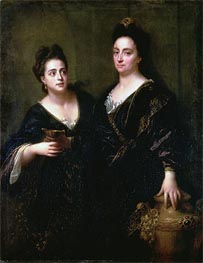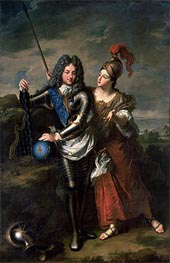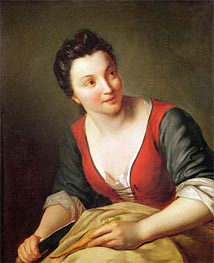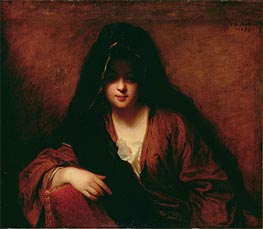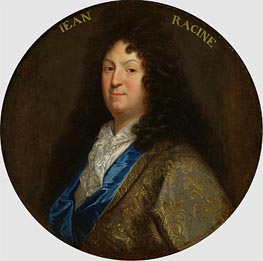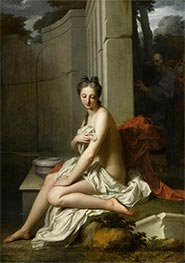
Jean-Baptiste Santerre Giclée Fine Art Prints
1651-1717
French Baroque Painter
Jean-Baptiste Santerre was a French painter who was born on March 23, 1651, in Magny-en-Vexin, France, and died on November 21, 1717, in Paris. He was known for his portraits and religious and mythological paintings.
Santerre was born into a family of artists. His father was a portrait painter, and it is believed that he received his initial artistic training from him. He later studied under the painter Bon Boullogne in Paris, refining his skills and developing a deep understanding of classical art.
Santerre gained recognition and success as a portrait painter. He became a member of the Royal Academy of Painting and Sculpture in Paris in 1673, which further enhanced his reputation. His skillful technique and ability to capture the likeness and personality of his subjects made him a sought-after portraitist among the French aristocracy and upper class.
In addition to portraits, Santerre also created religious and mythological paintings. He painted scenes from the Bible, such as "The Annunciation" and "The Adoration of the Shepherds," as well as mythological subjects, including "Jupiter and Antiope" and "Venus and Adonis." His works often showcased his ability to depict delicate details and use vibrant colors.
Santerre's style was influenced by the classical traditions of painting, particularly the works of Nicolas Poussin and Charles Le Brun. He incorporated elements of both the Baroque and Rococo styles into his compositions. His paintings were characterized by their smooth brushwork, refined elegance, and a sense of harmony.
Santerre enjoyed the patronage of prominent figures, including King Louis XIV. He received several commissions from the royal court, further establishing his reputation as a skilled painter. He painted portraits of the king's mistresses, including Madame de Montespan and Madame de Maintenon.
Santerre was also an influential teacher. He served as a professor at the Royal Academy of Painting and Sculpture and had notable pupils, including François Boucher, who went on to become a prominent artist in his own right. Santerre's teaching played a role in shaping the future direction of French painting.
In the latter part of his career, Santerre's popularity waned as tastes in art began to shift. The rise of the Rococo style and the emergence of new artistic movements challenged the classical traditions that Santerre adhered to. He continued to paint but struggled to maintain his previous level of success. He died in Paris at the age of 66.
Jean-Baptiste Santerre's contributions to French painting during the late 17th and early 18th centuries solidified his place in art history. His skillful portraits and his ability to depict religious and mythological subjects with grace and elegance left a lasting impact on the French artistic tradition.
Santerre was born into a family of artists. His father was a portrait painter, and it is believed that he received his initial artistic training from him. He later studied under the painter Bon Boullogne in Paris, refining his skills and developing a deep understanding of classical art.
Santerre gained recognition and success as a portrait painter. He became a member of the Royal Academy of Painting and Sculpture in Paris in 1673, which further enhanced his reputation. His skillful technique and ability to capture the likeness and personality of his subjects made him a sought-after portraitist among the French aristocracy and upper class.
In addition to portraits, Santerre also created religious and mythological paintings. He painted scenes from the Bible, such as "The Annunciation" and "The Adoration of the Shepherds," as well as mythological subjects, including "Jupiter and Antiope" and "Venus and Adonis." His works often showcased his ability to depict delicate details and use vibrant colors.
Santerre's style was influenced by the classical traditions of painting, particularly the works of Nicolas Poussin and Charles Le Brun. He incorporated elements of both the Baroque and Rococo styles into his compositions. His paintings were characterized by their smooth brushwork, refined elegance, and a sense of harmony.
Santerre enjoyed the patronage of prominent figures, including King Louis XIV. He received several commissions from the royal court, further establishing his reputation as a skilled painter. He painted portraits of the king's mistresses, including Madame de Montespan and Madame de Maintenon.
Santerre was also an influential teacher. He served as a professor at the Royal Academy of Painting and Sculpture and had notable pupils, including François Boucher, who went on to become a prominent artist in his own right. Santerre's teaching played a role in shaping the future direction of French painting.
In the latter part of his career, Santerre's popularity waned as tastes in art began to shift. The rise of the Rococo style and the emergence of new artistic movements challenged the classical traditions that Santerre adhered to. He continued to paint but struggled to maintain his previous level of success. He died in Paris at the age of 66.
Jean-Baptiste Santerre's contributions to French painting during the late 17th and early 18th centuries solidified his place in art history. His skillful portraits and his ability to depict religious and mythological subjects with grace and elegance left a lasting impact on the French artistic tradition.
6 Jean-Baptiste Santerre Artworks
SKU: 12443-SJB
Jean-Baptiste Santerre
Original Size:146 x 114 cm
The State Hermitage Museum, St. Petersburg, Russia
Jean-Baptiste Santerre
Original Size:146 x 114 cm
The State Hermitage Museum, St. Petersburg, Russia
SKU: 10034-SJB
Jean-Baptiste Santerre
Original Size:unknown
Museum of Palace of Versailles, Paris, France
Jean-Baptiste Santerre
Original Size:unknown
Museum of Palace of Versailles, Paris, France
SKU: 10033-SJB
Jean-Baptiste Santerre
Original Size:unknown
Musee des Beaux Arts, Nantes, France
Jean-Baptiste Santerre
Original Size:unknown
Musee des Beaux Arts, Nantes, France
SKU: 10032-SJB
Jean-Baptiste Santerre
Original Size:80 x 92 cm
The State Hermitage Museum, St. Petersburg, Russia
Jean-Baptiste Santerre
Original Size:80 x 92 cm
The State Hermitage Museum, St. Petersburg, Russia
SKU: 10031-SJB
Jean-Baptiste Santerre
Original Size:75 x 75 cm
Museum of Palace of Versailles, Paris, France
Jean-Baptiste Santerre
Original Size:75 x 75 cm
Museum of Palace of Versailles, Paris, France
SKU: 3329-SJB
Jean-Baptiste Santerre
Original Size:205 x 145 cm
Louvre Museum, Paris, France
Jean-Baptiste Santerre
Original Size:205 x 145 cm
Louvre Museum, Paris, France
